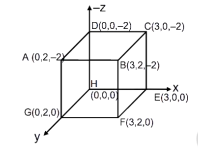
An electric field $\vec {E}=~4x \hat {i}+\left({y^2}+1\right)~\hat {j}$ passes through the box shown in figure. The flux of the electric field through surface ABCD and BCGF are marked as
${{\phi }_{1}}$ And ${{\phi }_{2}}$, then difference between ${{\phi }_{1}}-{{\phi }_{2}}$ is_____ ($N{m^2}$/C )

Answer
220.2k+ views
Hint: We know that, the amount of electric lines of force (or electric field lines), which cross a specific area, is referred to as electric flux, a feature of an electric field. The amount of electric flux is directly proportional to the area its passing through. In this problem, we will use the equation of electric flux on both the surfaces ABCD and BCGF separately to find the difference between ${{\phi }_{1}}-{{\phi }_{2}}$.
Formula used:
$\phi = E~A~\cos \theta$
Where,
E- The magnitude of the electric field.
A -The surface area
$\theta $- The angle formed by the plane and an axis
Complete answer:
Electric flux is defined as the total number of electric field lines traversing a specific area in a particular amount of time. If the plane is perpendicular to the direction of the electric field, the total flux is given as follows:
${{\phi }_{P}}=EA$
When the same plane is slanted at an angle, the projected area is given as $\theta $, and the total flux across this surface is given as:
$\phi =EA\cos \theta $
Where,
E represents the magnitude of the electric field.
A represents the surface area through which the electric flux must be estimated.
$\theta $is the angle formed by the plane and an axis that are parallel to the direction the electric field is flowing.
Electric flux through a surface is
$\phi =\int{\vec{E}=d\vec{A}}$
For surface ABCD, $d\vec{A}$ is along $-\hat {k}$. So, at all the points of this surface:
$\vec{E}.d\vec{A}=0$
Because,
${{\phi }_{ABCD}}={{\phi }_{1}}=0$
For surface BCEF, $d\vec{A}$ is along $\hat {i}$
So,
$\vec{E}.d\vec{A}={{E}_{x}}dA$
${{\phi }_{BCEF}}={{\phi }_{2}}=4x(2\times 2)$
If $x=3$ (From diagram we can see the value of x is 3)
${{\phi }_{2}}=48N{{m}^{2}}/C$
${{\phi }_{1}}-{{\phi }_{2}}=-48N{{m}^{2}}/C$
So, the answer is $-48N{{m}^{2}}/C$
Note: When placed parallel to the electric field, a surface won't allow any electric field lines to travel through it. When a surface is positioned perpendicular to the electric field, the maximum amount of electric field lines of force travel through it.
Formula used:
$\phi = E~A~\cos \theta$
Where,
E- The magnitude of the electric field.
A -The surface area
$\theta $- The angle formed by the plane and an axis
Complete answer:
Electric flux is defined as the total number of electric field lines traversing a specific area in a particular amount of time. If the plane is perpendicular to the direction of the electric field, the total flux is given as follows:
${{\phi }_{P}}=EA$
When the same plane is slanted at an angle, the projected area is given as $\theta $, and the total flux across this surface is given as:
$\phi =EA\cos \theta $
Where,
E represents the magnitude of the electric field.
A represents the surface area through which the electric flux must be estimated.
$\theta $is the angle formed by the plane and an axis that are parallel to the direction the electric field is flowing.
Electric flux through a surface is
$\phi =\int{\vec{E}=d\vec{A}}$
For surface ABCD, $d\vec{A}$ is along $-\hat {k}$. So, at all the points of this surface:
$\vec{E}.d\vec{A}=0$
Because,
${{\phi }_{ABCD}}={{\phi }_{1}}=0$
For surface BCEF, $d\vec{A}$ is along $\hat {i}$
So,
$\vec{E}.d\vec{A}={{E}_{x}}dA$
${{\phi }_{BCEF}}={{\phi }_{2}}=4x(2\times 2)$
If $x=3$ (From diagram we can see the value of x is 3)
${{\phi }_{2}}=48N{{m}^{2}}/C$
${{\phi }_{1}}-{{\phi }_{2}}=-48N{{m}^{2}}/C$
So, the answer is $-48N{{m}^{2}}/C$
Note: When placed parallel to the electric field, a surface won't allow any electric field lines to travel through it. When a surface is positioned perpendicular to the electric field, the maximum amount of electric field lines of force travel through it.
Recently Updated Pages
Electricity and Magnetism Explained: Key Concepts & Applications

JEE Energetics Important Concepts and Tips for Exam Preparation

JEE Isolation, Preparation and Properties of Non-metals Important Concepts and Tips for Exam Preparation

JEE Main 2021 July 25 Shift 1 Question Paper with Answer Key

JEE Main 2021 July 22 Shift 2 Question Paper with Answer Key

States of Matter Chapter For JEE Main Chemistry

Trending doubts
JEE Main 2026: Application Form Open, Exam Dates, Syllabus, Eligibility & Question Papers

Understanding Uniform Acceleration in Physics

Derivation of Equation of Trajectory Explained for Students

Hybridisation in Chemistry – Concept, Types & Applications

Understanding the Angle of Deviation in a Prism

How to Convert a Galvanometer into an Ammeter or Voltmeter

Other Pages
JEE Advanced Marks vs Ranks 2025: Understanding Category-wise Qualifying Marks and Previous Year Cut-offs

Dual Nature of Radiation and Matter Class 12 Physics Chapter 11 CBSE Notes - 2025-26

Understanding Centrifugal Force in Physics

JEE Main Marking Scheme 2026- Paper-Wise Marks Distribution and Negative Marking Details

Degree of Dissociation: Meaning, Formula, Calculation & Uses

Ideal and Non-Ideal Solutions Explained for Class 12 Chemistry




